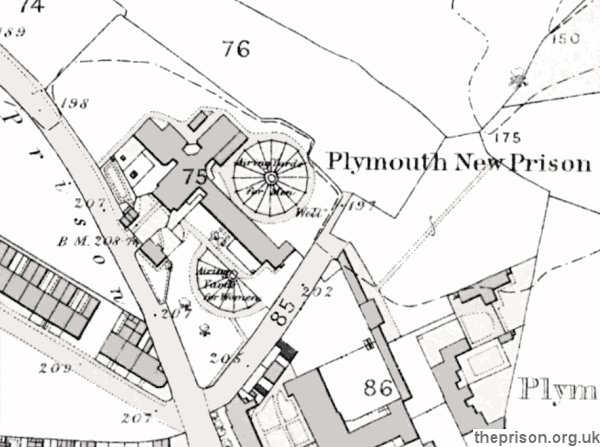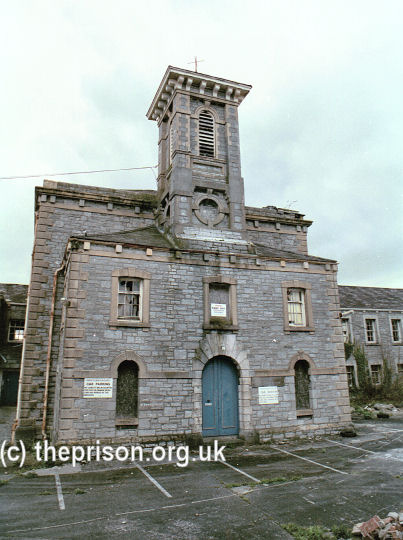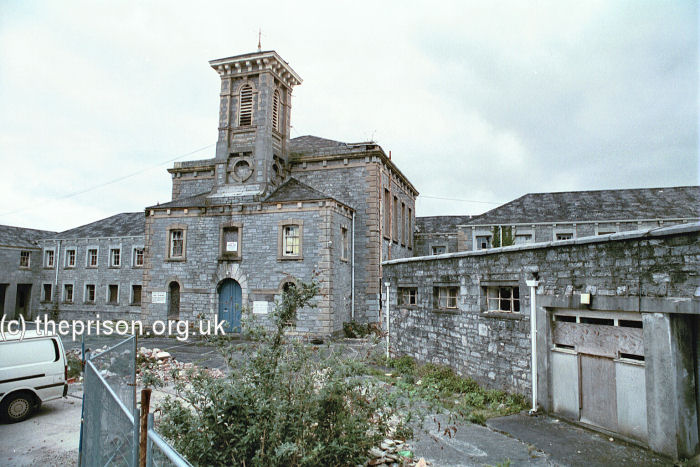Borough Gaol, Plymouth, Devon
The Plymouth Borough Gaol was located adjacent to and partly beneath the town's Guildhall at the junction of Whimple Street and High Street.
In 1784, John Howard described it as follows:
Three rooms for felons &c. and two rooms over them for debtors. One of the former, the clink, 15 feet by 8 feet 3 inches, and about 5½ feet high, with a wicket in the door 7 inches by 5 to admit light and air. To this, as I was informed, three men who were confined near two months under sentence of transportation, came by turns for breath. The door had not been opened for five weeks when I with difficulty entered to see a pale inhabitant. He had been there ten weeks under sentence of transportation, and said he had much rather have been hanged than confined in that noisome cell. In another room (13 feet by 5½ and 6 feet 9 inches high, the window only 18 inches by 14, and the wall 2 feet 8 inches thick), at my last visit there were two prisoners; one of whom assured me he had been there upwards of seven weeks, and sometimes, with four or five other prisoners, where they were almost suffocated.—The other room is for women (17 feet by 10). The whole is dirty, and has not been white-washed for many years. No court: no water. The gaolers live distant; they are the three sergeants at mace. Fees, 15s. 4d. no table. Allowance to debtors, none but on application: felons, two-pennyworth of bread a day. No straw.
| Debtors. | Felons &c. | Debtors. | Felons &c. | ||
| 1774, Sep. 15, | 3, | 1. | 1779, Feb. 2, | 1 | 0. |
| 1775, Dec. 17, | 0 | 0. | 1782, July 30, | 4. | 4. |
In 1812, James Neild wrote:
This Gaol adjoins to, and is partly under the Guild or Town-Hall. A door from hence opens into it ;through which the Prisoners are brought into Court for trial, by a flight of seventeen steps.
Here are three rooms on an upper-story, for Debtors, with a fire-place in each; but no firing is allowed: Their accommodation is straw-in-sacking on crib-bedsteads, one blanket, and two rugs. They have also the use of the attic story, which is 19 feet by 12,and 7 feet high; and likewise of the flat-roof, 21 feet by 12, to walk on, and take the air. It is carefully enclosed by a wall 14 feet high, and topped with a wooden chevaux de frise.
Below, on the ground-floor, are three cells for Felons, of 9 feet by 5, with arched roofs, and two iron-grated and opposite windows: one of which looks toward the Corn-market; the other into a lobby or passage, 3 feet wide, which has a grated window opening toward Bowl-Hill. The next story has two cells, about 12 feet by 10, and 7 feet high. The story above this is called the Women's Gaol, containing two rooms, with boarded floors, glazed windows, and in each a fire-place: Yet, at the time of my visit, the three wretched Prisoners were put together in one of the rooms, although one of them had a young child; another had the itch; and the third said, that the straw of her bed (the only bedding they are allowed) had not been changed in seven months: it was indeed, literally,worn to dust.
The Prisoners hold a constant communication with the street; and by letting down a hat, or a canister,receive the casual charity of passengers, in money, &c. Convicts under Sentence of Transportation have not the King's allowance of 2s. 6d. a week.
The whole Prison is dirty in the extreme: the lowermost cells were filthy beyond conception, with urine and excrement. The Gaolers live distant from their charge, to which they can hardly pay more than a divided attention, whose effects are too glaring. Here is no day-room; No court-yard; and the Gaol is but ill supplied with water. No firing.
The respectable Mayor of Plymouth politely accompanied me; and from him. I learned "that it was in contemplation to build a new Prison." No Employment provided. The Act and Clauses are both hung up.
Gaolers, Thomas Tatam, Geo. Pardon, Thomas Towton, Serjeants at Mace.
Salary, 15l. each per annum..
Fees, Debtors, on arrest, 15s. on discharge, 15s. 4d. No Table. Conveyance Transports paid, according to the expence incurred.
Chaplain, none.
Surgeon, Mr. Richardson: makes a Bill.
| Number of Prisoners | Debtors. | Felons &c. |
| 1803, Oct. 9th, | 1 | 8. |
| 1806, Oct. 10th, | 0 | 9. |
Allowance; Debtors, a threepenny loaf per day, upon Petition as Paupers: weight, in Oct. 1806, i lb. 5 oz. Felons,and other Criminals,the same.
In 1849, the prison relocated to new premises on Greenbank Road, adjacent to where construction of a new Plymouth workhouse was about to begin. Following the model design of Pentonville, the new prison (or 'prisons', i.e. having male and female sections), designed by Messrs Fuller and Gingell of Bath, had a radial layout with three two-storey wings connected to a central hub. As with all new prisons of that period, the buildings implemented the 'separate' system of one inmate per cell and isolation when outside the cell, such as in the segmented exercise yards and partitioned seats in the chapel. The site is shown on the 1857 map below.

Borough Gaol and Bridewell site, Plymouth, c.1857.
A directory of the time recorded:
The new Borough Prisons, which were completed in 1849, are pleasantly situated on the north-east side of the town, and cost about £13,500, of which about £35OO was derived from the freeman's, or prison fund, and £10,000 was borrowed, chiefly from the Exchequer Loan Commissioners. They are handsomely built of blue limestone, relieved by Caen-stone dressings, and the sashes are all of cast iron, glazed with plate glass a quarter of an inch thick. They are generally in the Italian style, and the lofty boundary wall encloses about three acres, divided into airing grounds, &c. The governor's house and porter's lodge are on each side of the entrance. The prisons are at the centre of the ground, and are disposed in three large wings, comprising the governors offices, apartments for the matron, a chapel and surgery, visiting cells, convalescent. rooms, a bath room, and cells for 60 prisoners, including six for male and three for female debtors, for whom there are comfortable day rooms and airing grounds. There are four solitary cells, so constructed as to admit air, but no light; and there are 24 airing grounds, radiating from a common centre, and each to be occupied by only one prisoner at a time, whilst an officer is so placed as to be able to see into all the yards, the arrangements having been so made as to carry out the separate system, in all its completeness, both in the prisons and the chapel.
In 1878, following the nationalisation of the prison system, the establishment became HMP Plymouth. It closed in 1930. Parts of the site were later home to a laundry and police, fire and ambulance stations, and now a supermarket. The surviving south-west and south-east sections of the building are now used as student accommodation.

Borough Gaol entrance block from the west, Plymouth, 2001. © Peter Higginbotham

Borough Gaol from the south-west, Plymouth, 2001. © Peter Higginbotham
Records
Note: many repositories impose a closure period of up to 100 years for records identifying individuals. Before travelling a long distance, always check that the records you want to consult will be available.
- Devon Heritage Centre, Great Moor House, Bittern Road, Sowton Exeter EX2 7NL. Holdings include: Nominal Registers for Plymouth Prison (1881-1905); Plymouth prison registers (1867-91); Plymouth Gaol lists of prisoners (1854-7).
- Plymouth Prison Registers (1847-1881) can be viewed online on Find My Past.
- The National Archives, Kew, Richmond, Surrey, TW9 4DU. Has a wide variety of crime and prison records going back to the 1770s, including calendars of prisoners, prison registers and criminal registers.
- Find My Past has digitized many of the National Archives' prison records, including prisoner-of-war records, plus a variety of local records including Manchester, York and Plymouth. More information.
- Prison-related records on
Ancestry UK
include Prison Commission Records, 1770-1951
, and local records from London, Swansea, Gloucesterhire and West Yorkshire. More information.
- The Genealogist also has a number of National Archives' prison records. More information.
Census
Bibliography
- Higginbotham, Peter The Prison Cookbook: A History of the English Prison and its Food (2010, The History Press)
- Brodie, A. Behind Bars - The Hidden Architecture of England's Prisons (2000, English Heritage)
- Brodie, A., Croom, J. & Davies, J.O. English Prisons: An Architectural History (2002, English Heritage)
- Harding, C., Hines, B., Ireland, R., Rawlings, P. Imprisonment in England and Wales (1985, Croom Helm)
- McConville, Sean A History of English Prison Administration: Volume I 1750-1877 (1981, Routledge & Kegan Paul)
- Morris, N. and Rothman, D.G. (eds.) The Oxfod History of the Prison (1997, OUP)
- Pugh R.B. Imprisonment in Medieval England (1968, CUP)
Links
- Prison Oracle - resources those involved in present-day UK prisons.
- GOV.UK - UK Government's information on sentencing, probation and support for families.
Except where indicated, this page () © Peter Higginbotham. Contents may not be reproduced without permission.



